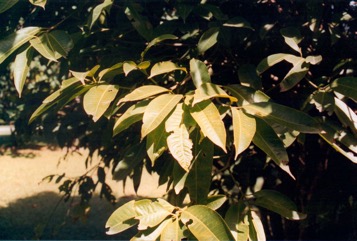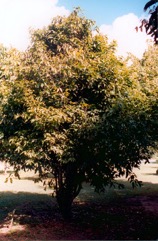Maprang

A tropical plant. It grows in the lowlands. It grows in the humid tropics. It does best in light fertile soil. It grows naturally up to 300 m altitude but has been planted up to 850 m altitude. In Cairns Botanical Gardens.
Also known as:
Bandaria, Gandaria, Gondongan, Jantake, Kondongan, Kundag, Kundang, Kundang daun besar, Kundangan setar, Ma praang, Pao gandari, Rembunia, Remenya, Rumenia, Setar, Si-kundangan, Somprang, Star
Synonyms
- Bouea gandaria Bl.
- Tropidopetalum javanicum Turcz.
Edible Portion
- Fruit, Leaves
Where does Maprang grow?
Found in: Asia, Australia, Bangladesh, China, Cuba, Indochina, Indonesia, Laos, Malaysia, Myanmar, Peru, Puerto Rico, SE Asia, Singapore, South America, Taiwan, Thailand
Notes: There are 3 accepted Bouea species.
Status: It is a cultivated food plant. Fruit are sold in markets. The young leaves are also sold in markets.
Growing Maprang
Cultivation: Plants are normally grown from seed. It can be grown by air-layering or grafting. A spacing of 10 m x 12 m is used. Young plants need shade.
Edible Uses: The ripe fruit are used fresh or cooked and used in preserves. They are peeled. The young green fruit are pickled for curries. The young leaves can be eaten fresh and with rice.
Production: The first harvest is ready after 8-10 years using seedlings and after 5-6 years using vegetative plants. A mature tree can produce 200 kg of fruit in a season.
Nutrition Info
per 100g edible portion| Edible Part | Energy (kcal) | Protein (g) | Iron (mg) | Vitamin A (ug) | Vitamin c (mg) | Zinc (mg) | % Water |
|---|---|---|---|---|---|---|---|
| Fruit | 60 | 0.8 | 0.9 | - | - | - | 83 |
| Leaves | 60 | 3.1 | 4.7 | - | - | - | 81 |
Maprang Photos


References
Ali, A. M. S., 2005, Homegardens in Smallholder Farming Systems: Examples from Bangladesh. Human Ecology, Vol. 33, No. 2 pp. 245-270
Arora, R. K., 2014, Diversity in Underutilized Plant Species - An Asia-Pacific Perspective. Bioversity International. p 60
Bircher, A. G. & Bircher, W. H., 2000, Encyclopedia of Fruit Trees and Edible Flowering Plants in Egypt and the Subtropics. AUC Press. p 62
Burkill, I.H., 1966, A Dictionary of the Economic Products of the Malay Peninsula. Ministry of Agriculture and Cooperatives, Kuala Lumpur, Malaysia. Vol 1 (A-H) p 358
Chayamarit, K., 1994, Preliminary Checklist of the Family Anacardiaceae in Thailand. Thai For. Bull. 22:1-25
Coronel, R.E., 1982, Fruit Collections in the Philippines. IBPGR Newsletter p 9
Ding Hou, 1978, Anacardiaceae, in Flora Malesiana Ser 1 Vol 8(3) p 468
Facciola, S., 1998, Cornucopia 2: a Source Book of Edible Plants. Kampong Publications, p 9
Food Composition Tables for use in East Asia FAO http://www.fao.org/infoods/directory No. 414
Food Composition Tables for use in East Asia FAO http://www.fao.org/infoods/directory No. 828 (Bouea spp.)
Hu, Shiu-ying, 2005, Food Plants of China. The Chinese University Press. p 515
INFOODSUpdatedFGU-list.xls
J. Asiat. Soc. Bengal 23:635. 1854
Kiple, K.F. & Ornelas, K.C., (eds), 2000, The Cambridge World History of Food. CUP p 1798
Lembaga Biologi Nasional, 1977, Buah-Buahan, Balai Pustaka, Jakarta. p 38
Macmillan, H.F. (Revised Barlow, H.S., et al) 1991, Tropical Planting and Gardening. Sixth edition. Malayan Nature Society. Kuala Lumpur. p 295
Martin, F.W. & Ruberte, R.M., 1979, Edible Leaves of the Tropics. Antillian College Press, Mayaguez, Puerto Rico. p 174
Martin, F. W., et al, 1987, Perennial Edible Fruits of the Tropics. USDA Handbook 642 (As Bouea gandaria)
McMakin, P.D., 2000, Flowering Plants of Thailand. A Field Guide. White Lotus. p 104
Miguel, E., et al, 1989, A checklist of the cultivated plants of Cuba. Kulturpflanze 37. 1989, 211-357
Milow, P., et al, 2013, Malaysian species of plants with edible fruits or seeds and their evaluation. International Journal of Fruit Science. 14:1, 1-27
Morton, J. F., 1987, Fruits of Warm Climates. Wipf & Stock Publishers p 237
Norfaizal, , M., et al, 2014, Flora Diversity of Sungai Teris, Karu Wildlife reserve, Pahang, Malaysia. Journal of Wildlife and Parks (2014) 28 : 81-91
Ochse, J.J. et al, 1931, Vegetables of the Dutch East Indies. Asher reprint. p 35
Ong, H., et al, 2012, Traditional knowledge and usage of edible plants among the Semai community of Kampung Batu 16, Tapah, Perak, Malaysia. Scientific Research and Essays Vol. 7(4), pp. 441-445, 30 January, 2012
PROSEA (Plant Resources of South East Asia) handbook, Volume 2, 1991, Edible fruits and nut. p 98
Priyadi, H., et al, 2010, Five hundred plant species in Gunung Halimun Salak National Park West Java. A checklist including Sundanese names, distribution and use. CIFOR, FFPRI, SLU p 33
Rivero, J. A., y Brunner, B. R., 2007, Arborels frutales exoticas y poco conocidos en Puerto Rico. Universidad de Puerto Rico. p 12
Saw, L.G., LaFrankie, J. V. Kochummen, K. M., Yap S. K., 1991, Fruit Trees in a Malaysian Rain Forest. Economic Botany, Vol. 45, No. 1, pp. 120-136
Slik, F., www.asianplant.net
Soepadmo, E., et al (Eds), 1996, Tree Flora of Sabah and Sarawak. Volume 2 FRIM p 7
Suksri, S., et al, 2005, Ethnobotany in Bung Khong Long Non-Hunting Area, Northeast Thailand. Kasetsart J., (Nat. Sci) 39: 519-533
Sukarya, D. G., (Ed.) 2013, 3,500 Plant Species of the Botanic Gardens of Indonesia. LIPI p 160
Tankard, G., 1990, Tropical fruit. An Australian Guide to Growing and using exotic fruit. Viking p 111
Tate, D., 1999, Tropical Fruit. Archipelago Press. Singapore. p 38
Terra, G.J.A., 1973, Tropical Vegetables. Communication 54e Royal Tropical Institute, Amsterdam, p 29
Tominaga, T., 1992, Fruits and Vegetables in Markets in Bintulu, Sarawak, Malaysia. Journ. Fac. Agri. Shinshu Univ. 29:137-147
USDA, ARS, National Genetic Resources Program. Germplasm Resources Information Network - (GRIN). [Online Database] National Germplasm Resources Laboratory, Beltsville, Maryland. Available: www.ars-grin.gov/cgi-bin/npgs/html/econ.pl (10 April 2000)
Wong, K. C., Collection and Evaluation of Under-Utilized Tropical and Subtropical Fruit Tree Genetic Resources in Malaysia. JIRCAS International Symposium Series No. 3: 27-38
World Checklist of Useful Plant Species 2020. Royal Botanic Gardens, Kew
Zawiah, N. & Othaman, H., 2012, 99 Spesies Buah di FRIM. Institut Penyelidikan Perhutanan Malaysia. p 70